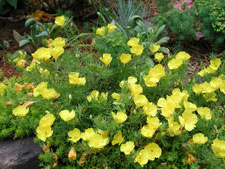Resource Library
Plant of the Week: Shrubby Primrose
The University of Arkansas System Division of Agriculture does not promote, support or recommend plants featured in "Plant of the Week." Please consult your local Extension office for plants suitable for your region.
Plant of the Week
[A-Z]
Shrubby primrose
Latin: Calylophus drummondianus

Every garden has them. Places where heat and drought make it difficult to keep plants alive, especially plants that look good. Shrubby primrose or Texas sundrop (Calylophus drummondianus), a native of the parched southwestern plains, is the kind of plant that not only grows well in those locations, but also shines.
The half dozen species of Calylophus are all similar with woody bases and herbaceous stems. Most are found in the southern Great Plains region and adjacent areas in Mexico. The gray-green leaves of this species are willow-like but only about one-eighth inch wide and to 2 inches long. Texas sundrop grows about 18 inches tall and 24 inches wide. Plants are mostly evergreen with only the slender stems and tips of the branches dying during hard freezes.
Near the ends of the slender branches plants produce large, four-petaled yellow flowers to 2 inches across that open in the evening and fade away late the next afternoon. Peak bloom is usually in late spring but plants continue to flower whenever enough rain comes to cause new growth.
Calylophus drummondianus is a plant with an identity crisis. Actually it is secure in its existence but the botanists studying it have had problems deciding what to call it. It belongs to the evening primrose family (Onagraceae) and is currently known as Calylophus berlandieri ssp. pinifolius, but in cultivation the first name is more common.
Superficially the Calylophus resemble evening primroses in the genus Oenothera, but if you look closely there are recognizable differences. The defining feature is the stigma, the receptive area for receiving pollen. In the larger genus Oenothera the stigma is divided into four pronounced filaments but in Calylophus it is a round nubbin.
This was enough difference for Edouard Spach, a French botanist, to separate the group from the evening primroses back in 1835. He coined the new generic name to describe their unique calyx with a crested lobe.
My initial interest in growing this plant was because it was offered incorrectly in a catalog as Calylophus drummondii. Thomas Drummond was a plant collector sent out by London’s Kew Gardens to collect plants in Texas. He died in 1835 on his way back home during a stopover in Cuba. Many good garden plants, including the annual phlox (Phlox drummondii), are named in his honor. Texas botanists are fond of all things Drummond and now list the plant I grow as C. drummondianus var. berlandieri.
Botanists without a Texas connection prefer Calylophus berlandieri ssp. pinifolius, honoring the French plant collector Jean Berlandier who collected plants in Mexico between 1826 and 1834. Berlandier was part of the team assigned to survey and establish the Mexican borderline so perhaps this explains why Texans prefer the Scotsman’s name.
Whatever it is called, Calylophus should be planted in well drained areas in full sun or light shade. Though typically found in soils with a neutral or even alkaline pH, it does equally well in more acidic sites. It is winter hardy to zone 6. In more severe winters the plant may freeze back but this does not interfere with flowering as blooms are produced on new growth. To maintain a tidy appearance, prune plants back during early spring. As long as good drainage is provided, pest problems seem rare.
By: Gerald Klingaman, retired
Extension Horticulturist - Ornamentals
Extension News - June 20, 2008
The University of Arkansas System Division of Agriculture does not maintain lists of retail outlets where these plants can be purchased. Please check your local nursery or other retail outlets to ask about the availability of these plants for your growing area.